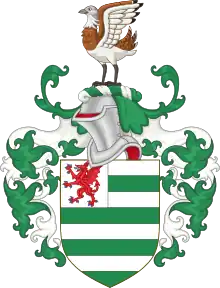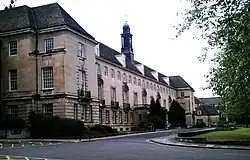Wiltshire Council | |
|---|---|
 The coat of arms of the council | |
The logo of the council | |
| Type | |
| Type | |
| History | |
| Founded | 1 April 1889 |
| Preceded by | District councils
|
| Leadership | |
Chairman of the Council | |
Leader of the Council | |
Chief executive | Terence Herbert[1] since 26 June 2020 |
| Structure | |
| Seats | 98 councillors |
 | |
Political groups |
|
Length of term | 4 years |
| Elections | |
| First past the post | |
Last election | 6 May 2021 |
Next election | May 2025 |
| Meeting place | |
 | |
| County Hall, Trowbridge | |
| Website | |
| wiltshire | |
Wiltshire Council, known between 1889 and 2009 as Wiltshire County Council, is a unitary authority which governs the district of Wiltshire, which covers the majority of the ceremonial county of the same name in South West England. The council has been controlled by the Conservative Party since 2000, and has its headquarters at County Hall in Trowbridge.
Between 1974 and 1997 Wiltshire was a two-tier metropolitan county with five districts: Kennet, North Wiltshire, Salisbury, Thamesdown, and West Wiltshire. In 1997 Thamesdown was reorganised as a unitary authority, being renamed 'Swindon' and removed from the non-metropolitan county. In 2009 the remaining four districts were abolished and their functions taken over by the county council. Since 1974 the Conservative Party has been the largest party on the council almost continuously; between the 1993 and 1997 local elections the Liberal Democrats held the most seats.
History

Wiltshire County Council was established on 1 April 1889 under the Local Government Act 1888, taking over administrative functions until then carried out by the unelected Quarter Sessions.[2] The first elections to the new county council were held on 23 January 1889; the council had sixty seats, but in twenty-eight the candidate ran unopposed.[3] The first provisional meeting of the council was held at Devizes on 31 January 1889.[4]
In 1896, the County Council acquired Arlington House on The Parade in Trowbridge to act as offices, and the building was extended in 1900 and 1913.[5][6] In 1930, the council decided to build a new county hall in Devizes, which is near the geographical centre of Wiltshire, but construction was delayed and in 1933 the decision was reversed.[7] Nevertheless a new County Hall was built at Trowbridge, and opened in 1940. The council was granted a coat of arms in 1937.[8]
Wiltshire had a large number of urban district and rural district councils until 1974, when local government was reorganised in England and Wales and the districts were amalgamated into five: Kennet, North Wiltshire, Salisbury, West Wiltshire and the borough of Thamesdown. In 1997, Thamesdown was renamed 'Swindon' and reorganised into a single-tier unitary authority. This removed the borough from the non-metropolitan county, reducing its population by almost a third, although it remains part of the ceremonial county.
On 5 December 2007, the Government announced that the rest of Wiltshire would be reorganised into a unitary status. This was later put into effect by a statutory instrument as part of the 2009 structural changes to local government. The four remaining districts were abolished and their functions taken over by Wiltshire County Council, which was renamed Wiltshire Council.
In 2012, the County Hall was renovated and expanded at a cost of about £24 million.[9] Services provided to the public in the building include the Trowbridge library,[9] and the main office of the council's Registration Service.[10]
Functions
The unitary authority provides local government services to 435,000 Wiltshire residents and is also the biggest employer in Wiltshire, being responsible for schools, social services, rubbish collection and disposal, county roads, planning, and leisure services.
Most executive decisions are taken by the authority's cabinet, each member of which has a particular area of responsibility. Development control is undertaken by five planning committees, the powers of which cannot be exercised by the cabinet. Members of the authority are appointed to a wide range of outside bodies, providing them with some element of democratic accountability, such as the Kennet and Avon Canal Trust, the Wiltshire Victoria County History, and the Wiltshire Historic Buildings Trust.
Political balance
After the 2021 local elections the council consisted of 61 Conservative councillors, 27 Liberal Democrats, seven independents, and three Labour councillors. Following the death of Conservative councillor Mary Webb in August 2022 a by-election was held in Salisbury St Paul's ward on 3 November for both Wiltshire Council and Salisbury City Council.[11] The Liberal Democrats gained the seat, giving them their largest number of seats since the creation of the council.[12] In April 2021, Independent Jack Oatley joined the Conservative group, bringing them back up to 61.[13]
Electoral history
Since 1889, members were elected for a term of office, with elections held all together (initially every three years, later every four years) on the "first past the post" system. Until the 1970s, the elected members chose aldermen, whose term of office was for six years, and who once appointed were also voting members of the council. This form of membership was ended by the Local Government Act 1972, so that after 1974 only honorary (that is, non-voting) aldermen could be appointed.
Until 2005, all of the county's electoral divisions elected a single member, but following a boundary review in 2004 three divisions (Salisbury South, Salisbury East, and Trowbridge East) elected two members each. The final size of the council was forty-nine members. The successor authority, Wiltshire Council, was established in 2009 with a total of ninety-eight members.
Between 2009 and 2013 the composition of the council changed significantly. After the 2009 local elections the council consisted of 62 Conservatives, 24 Liberal Democrats, seven independent councillors, three Devizes Guardians, and two Labour. In September 2009 and December 2010, an Independent joining UKIP while remaining in the Independent group,[14] a defection in May 2012 by a Liberal Democrat councillor to the Conservatives,[15] and in November 2012 by another Lib Dem and a Conservative to the Independents,[16] by the beginning of 2013 Wiltshire Council consisted of 61 Conservatives, 22 Liberal Democrats, ten Independents including one UKIP member, three Devizes Guardians, and two Labour members.
The elections of 2013 produced an unexpected swing to the Liberal Democrats, who made a net gain of five seats, while all three Devizes Guardians lost their seats to the Conservatives and the Labour group increased from two to four. The overall result was 58 Conservatives, 27 Liberals, eight Independents, four Labour, and one UKIP member.[17] However, during the following year four Liberal Democrats defected from their political group: one to the Conservatives and three to the Independents. In a by-election in May 2015 at Chippenham Hardenhuish, the Conservatives gained a seat from the Liberal Democrats, and in November they gained another at Salisbury St Edmund. At a by-election in May 2016 the Liberal Democrats gained Amesbury East from the Conservatives.
The 2017 election resulted in the Conservatives increasing their share of seats at the expense of the Liberal Democrats, Independents, Labour and UKIP. This trend reversed, however, in 2021 with the Liberal Democrats increasing their number to 27 – their joint highest since the creation of the council.
Election results
| Political group | Councillors | |||||
|---|---|---|---|---|---|---|
| 2009 | 2013 | 2017 | 2021 | Current[18] | ||
| Conservative | 62 | 58 | 68 | 61 | 61 | |
| Liberal Democrat | 24 | 27 | 20 | 27 | 28 | |
| Independent | 7 | 8 | 7 | 7 | 6 | |
| Labour | 2 | 4 | 3 | 3 | 3 | |
| Devizes Guardians | 3 | 0 | 0 | 0 | 0 | |
| UK Independence Party | 0 | 1 | 0 | 0 | 0 | |
| Total | 98 | 98 | 98 | 98 | 98 | |
Divisions
Wiltshire Council has 98 divisions, each represented by one elected member.
See also
References
- ↑ "Cash strapped county unitary names new chief". Local Government Chronicle. 29 June 2020. Retrieved 1 July 2020.
- ↑ John Edwards, 'County' in Chambers's Encyclopaedia (London: George Newnes, 1955), pp. 189–191
- ↑ The Times, 19 January 1889; p. 12; col A.
- ↑ The Times, 1 February 1889, p. 10, col D.
- ↑ Historic England. "Arlington House, Trowbridge (1364231)". National Heritage List for England. Retrieved 13 August 2019.
- ↑ H. F. Chettle, W. R. Powell, P. A. Spalding, P. M. Tillott, 'Parishes: Trowbridge', in A History of the County of Wiltshire, Vol. 7 (London: 1953), pp. 125–171 at British History Online, accessed 23 August 2019
- ↑ Russell Lincoln Ackoff, Systems and management annual (1974), p. 380
- ↑ Civic Heraldry of England and Wales – Wiltshire page at civicheraldry.co.uk
- 1 2 Wilkinson, Mike (23 March 2012). "Peek at £24m Wiltshire County Hall revamp (From Wiltshire Times)". Wiltshire Times. Retrieved 30 September 2013.
- ↑ "Contact Registration Service". Wiltshire Council. Retrieved 3 February 2023.
- ↑ Griffin, Katy (10 August 2022). "Tributes to Salisbury councillor Mary Webb". Salisbury Journal. Retrieved 24 October 2022.
- ↑ "Unitary council election for Salisbury St Paul's Division on Thursday 3 November 2022". Wiltshire Council. Retrieved 24 February 2023.
- ↑ https://www.wiltshiretimes.co.uk/news/23482222.independent-melksham-councillor-joins-conservatives
- ↑ Explanation by Cllr Cuthbert Murray at westburytownforums.co.uk that he is both a UKIP member and an Independent
- ↑ "Wiltshire councillor joins Conservatives". ConservativeHome. 22 May 2012. Retrieved 23 May 2012.
- ↑ Gerald Isaaman, Councillor Peggy Dow quits the Lib-Dems as they suffer election humiliation at the polls (marlboroughnewsonline.co.uk)
- ↑ Election results at Wiltshire Council website
- ↑ "Your Councillors". Wiltshire Council. Retrieved 24 February 2023.
External links
- Official website

- Visit Wiltshire, part-funded by Wiltshire Council

.png.webp)
.png.webp)
.png.webp)
.png.webp)
.png.webp)
.png.webp)
.png.webp)